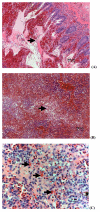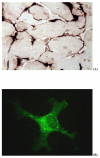First detection, isolation and molecular characterization of infectious salmon anaemia virus associated with clinical disease in farmed Atlantic salmon (Salmo salar) in Chile
- PMID: 18680586
- PMCID: PMC2519066
- DOI: 10.1186/1746-6148-4-28
First detection, isolation and molecular characterization of infectious salmon anaemia virus associated with clinical disease in farmed Atlantic salmon (Salmo salar) in Chile
Abstract
Background: Infectious salmon anaemia (ISA) is a viral disease of marine-farmed Atlantic salmon (Salmo salar) caused by ISA virus (ISAV), which belongs to the genus Isavirus, family Orthomyxoviridae. The virus is considered to be carried by marine wild fish and for over 25 years has caused major disease outbreaks in marine-farmed Atlantic salmon in the Northern hemisphere. In the Southern hemisphere, ISAV was first detected in Chile in 1999 in marine-farmed Coho salmon (Oncorhynchus kisutch). In contrast to the classical presentation of ISA in Atlantic salmon, the presence of ISAV in Chile until now has only been associated with a clinical condition called Icterus Syndrome in Coho salmon and virus isolation has not always been possible. During the winter of 2007, unexplained mortalities were registered in market-size Atlantic salmon in a grow-out site located in Chiloé in Region X of Chile. We report here the diagnostic findings of the first significant clinical outbreak of ISA in marine-farmed Atlantic salmon in Chile and the first characterization of the ISAV isolated from the affected fish.
Results: In mid-June 2007, an Atlantic salmon marine farm site located in central Chiloé Island in Region X of Chile registered a sudden increase in mortality following recovery from an outbreak of Pisciricketsiosis, which rose to a cumulative mortality of 13.6% by harvest time. Based on the clinical signs and lesions in the affected fish, and laboratory tests performed on the fish tissues, a confirmatory diagnosis of ISA was made; the first time ISA in its classical presentation and for the first time affecting farmed Atlantic salmon in Chile. Rapid sequencing of the virus-specific RT-PCR products amplified from the fish tissues identified the virus to belong to the European genotype (Genotype I) of the highly polymorphic region (HPR) group HPR 7b, but with an 11-amino acid insert in the fusion glycoprotein, and ability to cause cytopathic effects (CPE) in CHSE-214 cell line, characteristics which make it distinct from common European Genotype ISAV isolates from Europe and North America.
Conclusion: In conclusion, the present work constitutes the first report of a case of ISA in farmed Atlantic salmon in Chile. The clinical signs and lesions are consistent with the classical descriptions of the disease in marine-farmed Atlantic salmon in the Northern hemisphere. The outbreak was caused by ISAV of European genotype (or Genotype I) of HPR 7b but distinct from common European Genotype ISAV isolates.
Figures






References
-
- Kawaoka Y, Cox NJ, Haller O, Hongo S, Kaverin N, Klenk H-D, Lamb RA, McCauley J, Palese P, Rimstad E, Webster RG. Infectious Salmon Anaemia Virus. In: Fauquet CM, Mayo MA, Maniloff J, Desselberger U, Ball LA, editor. Virus Taxonomy – Eight Report of the International Committee on Taxonomy Viruses. Elsevier Academic Press: New York; 2005. pp. 681–693.
-
- Thorud KE, Djupvik HO. Infectious salmon anaemia in Atlantic salmon (Salmo salar L) Bull Eur Assoc Fish Pathol. 1988;8:109–111.
-
- Mullins JE, Groman D, Wadowska D. Infectious salmon anaemia in salt water Atlantic salmon (Salmo salar L) in New Brunswick, Canada. Bull Eur Assoc Fish Pathol. 1998;18:110–114.
-
- Rodger HD, Turnbull T, Muir F, Millar S, Richards R. Infectious salmon anaemia (ISA) in United Kingdom. Bull Eur Assoc Fish Pathol. 1998;18:115–116.
-
- Lyngøy C. Infectious salmon anaemia in Norway and the Faeroe Islands: An industrial approach. In: Miller O, Cipriano RC, editor. International response to infectious salmon anaemia: prevention, control, and eradication: proceedings of a symposium Tech Bull 1902. Washington, DC: U.S. Department of Agriculture, Animal and Plant Health Inspection Service; U.S. Department of the Interior, U.S. Geological Survey; U.S. Department of Commerce, National Marine Fisheries Service; 2003. pp. 97–109.
Publication types
MeSH terms
Substances
Associated data
- Actions
- Actions
- Actions
- Actions
LinkOut - more resources
Full Text Sources
Research Materials
Miscellaneous

